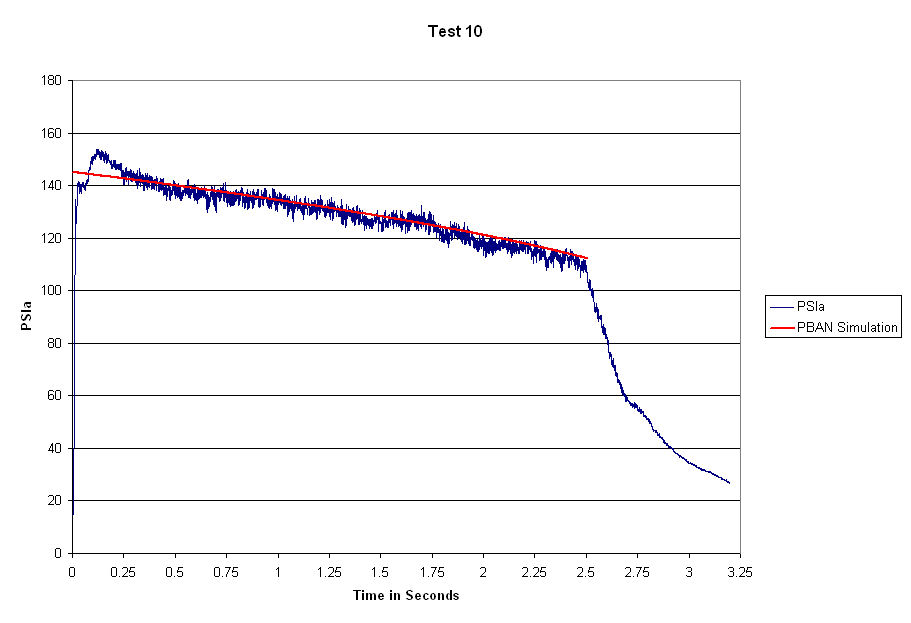
P1: Nitrous at Balls in '09
Testing
Simulation Analysis
Last Update, 1/1/09 by Stephen Daniel
Summary
This sections discusses the simulation of test #10. We show that by adjusting the injector Cd, the fuel regression rate, and the C* efficiency we can get a good fit to the burn time, the chamber pressure trace, and the mass of fuel consumed.
Assuming good data and good simulation models, we believe these derived values represent reasonable approximations to reality.
Discussion
We don't have a fuel regression model or CPROPEP entry for ABS, so we used PBAN for both.
We manually adjusted C* efficiency, injector Cd, and a fuel regression constant until the average pressure looked good and the run time and fuel mass consumed matched almost exactly.
The shape of the simulated pressure trace is a good match to the measured, with a couple of exceptions. The motor appears to have had some trouble coming up to pressure immediately. This is visible in the video as well. Test 11 starts instantly. I assume that in test 10 the pyro-valve did not immediately break free.
Early in the burn the chamber pressure is higher than expected. The igniters burn during the entire time the pyro-valve is cooking (about 16.8 seconds) and pre-heat the fuel grain. I assume this results in very high initial fuel regression.
The injector Cd that matches the burn time (0.37) is lower than we've been using for our design work. However our design has been guided by very approximate data. Furthermore we chose to design to a high injector Cd, on the theory that we could alwas add more holes in the injector later. I expect we will need to drill out the injector to achieve our target thrust.
The C* efficiency (72%) is much lower than our design goal of 95%. We believe that switching from a straight length of pipe to a fuel grain cast with mixing chambers forward and aft of the actual grain will significantly improve this.
To match the observed fuel consumed I had to cut the fuel regression almost in half (57.5%). Our fuel regression models suffer from a severe lack of data behind them.
Pressure Graph

Simulation Results
Section 1: Geometry
Tank Height 0.152 meters
Tank Volume 1.093 liters
Ullage Height 0.000 meters
Grain Length 0.297 meters
Nozzle Throat 1.000 inches
Nozzle Exit 1.600 inches
Nozzle Half Angle 15.0 degrees
C* Adjustment 0.72
Cf Adjustment 0.95
Ambient Pressure 1.0 atm
Section 2: Fill Conditions
N2O Supply Pressure 508.0 psi
Init Pressure 415.0 psi
Init Temp 26 F
Init N2O Mass 1.01 kg
Init N2O Density 0.92 g/cc
N2O Vented to chill 0.08 kg
0.18 lbs
Total N2O Consumed 2.40 lbs
Fuel PBAN
Section 3: Empty Conditions
Final Pressure 256.8 psi
Final Temp -5.1 F
Ullage N2O Mass 0.05 kg
Ullage Percentage 5.0 %
Section 4: Chamber Summary Init Final Average
Grain Port 3.042 3.162 3.104 inches
Grain Mass 0.442 0.332 kg
Fuel Consumed 0.110 kg
Min Max Average
Chamber Pressure 112.15 145.11 130.52 psi
O/F Ratio 8.3 9.0 8.7
Section 5: Injector Summary
Injector Count 8
Diameter of Injectors 1.78 mm
0.070 inches
Cd of Injectors 0.37
Tank/Chamber Pressure Ratio
Min Max Average
2.29 2.86 2.60
Section 6: Nozzle Summary Min Max Average
Exit Pressure 0.57 0.74 0.67 atm
Nozzle CF (un-adj) 1.32 1.32 1.32
Section 7: Performance Summary Init Min Max Average
Thrust 139 100 139 122 lbf
616 446 616 541 N
Delivered ISP 1298 1223 1298 1269 meters/sec
Delivered ISP 132 125 132 129 seconds
Burn Time 2.508 seconds
Total Impulse 1357 N-seconds
Motor Designation K-541 (6%)